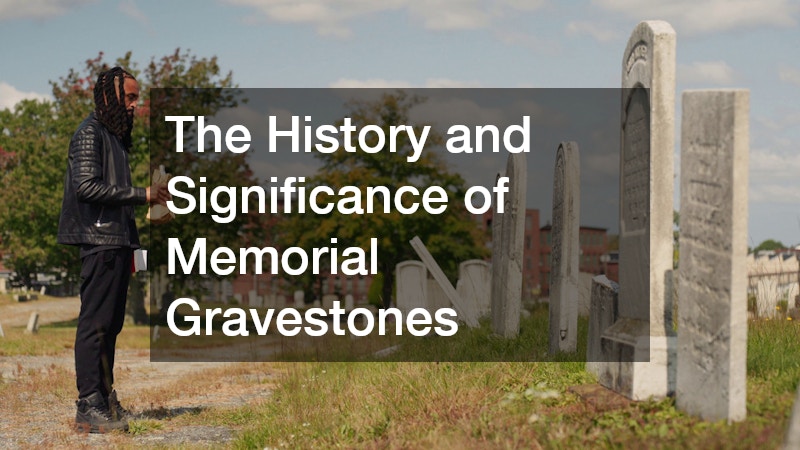The practice of commemorating the deceased through markers and monuments has been part of human culture for thousands of years. From ancient civilizations to modern cemeteries, memorial gravestones have served not only as indicators of a person’s final resting place but also as reflections of societal values, religious beliefs, and artistic expression. Understanding the history and significance of these markers provides insight into both the personal and cultural importance of remembering those who have passed.
Ancient Origins of Memorial Markers
The earliest forms of gravestones date back to ancient civilizations, where simple stones or piles of rocks marked burial sites. In ancient Egypt, tombs and stelae were elaborately decorated with hieroglyphics, detailing the achievements and lineage of the deceased. Similarly, in Mesopotamia, inscribed tablets served as memorials, blending both religious and historical documentation. These early markers were often symbolic, representing protection for the deceased in the afterlife and ensuring that their memory endured.
As societies developed, so did the complexity of burial markers. In ancient Greece and Rome, gravestones began to include carved reliefs and inscriptions that highlighted the deceased’s social status, accomplishments, and family connections. These markers served a dual purpose: they honored the individual and provided a record for posterity. Over time, the idea of memorializing the dead evolved beyond mere functionality to incorporate aesthetic and cultural significance.
Evolution Through the Middle Ages
During the Middle Ages, gravestones became increasingly influenced by religious traditions. In Europe, churchyards became common burial grounds, and markers were often adorned with Christian symbols such as crosses, angels, or biblical inscriptions. The gravestone not only commemorated the individual but also reflected the community’s spiritual values and beliefs about the afterlife. These symbols also served as a source of comfort and guidance for the living, reinforcing shared cultural and moral ideals.
The materials used in these markers also evolved. Stone, particularly limestone and sandstone, became standard due to its durability and ease of carving. Wealthier families could commission elaborate monuments, sometimes featuring sculpted effigies of the deceased. In contrast, simpler markers were used for common citizens, emphasizing the distinction between social classes even in death. This period highlighted the role of gravestones as both personal memorials and indicators of societal hierarchy. The choice of material and craftsmanship often conveyed not just wealth, but also the values and priorities of the family or community.
Cultural Variations Around the World
Memorial gravestones are not exclusive to Western traditions. Across Asia, Africa, and the Americas, different cultures developed unique ways to honor their dead. In Japan, family grave markers often include inscriptions of ancestors’ names and are maintained through ritual ceremonies, reflecting the importance of familial ties. In parts of Africa, burial sites might feature carved wooden or stone markers, symbolizing the individual’s connection to the community and spiritual world. Indigenous communities in the Americas traditionally used natural features, such as mounds or stones, to mark burial sites, often incorporating cultural symbolism to convey meaning. These practices demonstrate the creativity and diversity with which societies commemorate life and legacy.
These global variations underscore the universal human desire to remember and honor those who have passed. While materials, symbols, and practices may differ, the underlying purpose remains consistent: to create a lasting tribute that preserves the memory of the deceased and reinforces cultural values. They also highlight the ways in which communities adapt traditions to reflect their unique histories and beliefs. Such differences reveal how cultural context shapes the ways in which people express grief, respect, and remembrance.
Modern Memorial Gravestones
In contemporary society, memorial gravestones continue to evolve in both design and function. While traditional stone markers remain popular, modern options include bronze plaques, laser-engraved images, and even digital memorials that allow family members to share photos and stories online. These innovations reflect changing attitudes toward commemoration, emphasizing personalization and individual expression. Families now have the opportunity to create tributes that capture the unique personality and passions of their loved ones.
Today, these markers often incorporate symbols, quotes, or images that celebrate the life of the deceased rather than simply marking their passing. Cemeteries and memorial parks have become spaces where history, art, and personal memory intersect, allowing families to create meaningful tributes that resonate for generations. Additionally, eco-friendly options, such as biodegradable markers or natural stone settings, are gaining popularity, reflecting a growing awareness of environmental sustainability. The history and significance of memorial gravestones reveal much about humanity’s relationship with mortality, memory, and culture. From ancient steles and carved reliefs to modern personalized monuments, these tributes have consistently served as tangible expressions of love, respect, and remembrance. Beyond their functional role in marking burial sites, they carry deep cultural, spiritual, and emotional meaning, connecting the living with those who have passed and ensuring that legacies endure through time. Understanding this evolution allows us to appreciate not only the artistry and symbolism of these markers but also the enduring human desire to honor and remember those we have lost.

